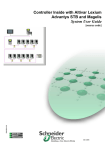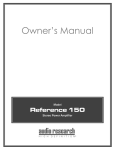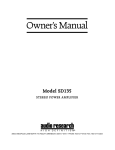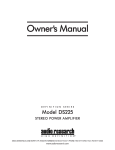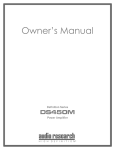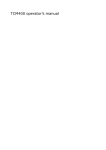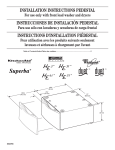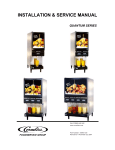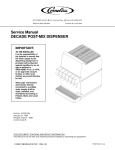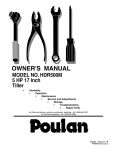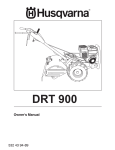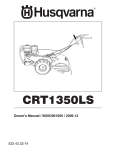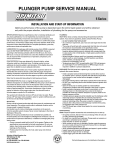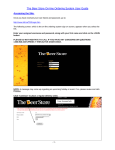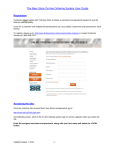Download Installation Service Manual Sentry III A Glycol Cooling
Transcript
CORNELIUS INC g One Cornelius Place g Anoka, MN 55303-6234 Telephone (800) 238-3600 Facsimile (612) 422-3246 Installation/Service Manual SENTRY III-A GLYCOL COOLING UNIT (R-134A REFRIGERANT) Part No. 111845000 Revised: May 13, 2014 Revision: B THIS DOCUMENT CONTAINS IMPORTANT INFORMATION This Manual must be read and understood before installing or operating this equipment Ó CORNELIUS INC; 1996-2014 PRINTED IN U.S.A TABLE OF CONTENTS Page SAFETY INFORMATION . . . . . . . . . . . . . . . . . . . . . . . . . . . . . . . . . . . . . . . . . . . . . . . . . . . . 1 RECOGNIZE SAFETY INFORMATION . . . . . . . . . . . . . . . . . . . . . . . . . . . . . . . UNDERSTAND SIGNAL WORDS . . . . . . . . . . . . . . . . . . . . . . . . . . . . . . . . . . . . 1 1 FOLLOW SAFETY INSTRUCTIONS . . . . . . . . . . . . . . . . . . . . . . . . . . . . . . . . . CO2 (CARBON DIOXIDE) WARNING . . . . . . . . . . . . . . . . . . . . . . . . . . . . . . . . SHIPPING, STORING, OR RELOCATING UNIT . . . . . . . . . . . . . . . . . . . . . . . GENERAL DESCRIPTION . . . . . . . . . . . . . . . . . . . . . . . . . . . . . . . . . . . . . . . . . . . . . . . . . . 1 1 1 3 SYSTEM DESCRIPTION . . . . . . . . . . . . . . . . . . . . . . . . . . . . . . . . . . . . . . . . . . . . . . . WARRANTY REFERENCE INFORMATION . . . . . . . . . . . . . . . . . . . . . . . . . . . . . . . 3 3 THEORY OF OPERATION . . . . . . . . . . . . . . . . . . . . . . . . . . . . . . . . . . . . . . . . . . . . . . 4 INSTALLATION . . . . . . . . . . . . . . . . . . . . . . . . . . . . . . . . . . . . . . . . . . . . . . . . . . . . . . . . . . . . 7 UNPACKING AND INSPECTION . . . . . . . . . . . . . . . . . . . . . . . . . . . . . . . . . . . . . . . . INSTALLING INSULATED BEER TRUNK LINE . . . . . . . . . . . . . . . . . . . . . . . . . . . . 7 7 SELECTING COOLING UNIT LOCATION . . . . . . . . . . . . . . . . . . . . . . . . . . . . . . . . . INSTALLING COOLING UNIT . . . . . . . . . . . . . . . . . . . . . . . . . . . . . . . . . . . . . . . . . . . PLACING COOLING UNIT IN OPERATING LOCATION . . . . . . . . . . . . . . . . CONNECTING COOLING UNIT GLYCOL LINES TO INSULATED BEER TRUNK LINE . . . . . . . . . . . . . . . . . . . . . . . . . . . . . . . . . . . . . . . . . . . . . . . . . . . . . . CONNECTING ELECTRICAL POWER CIRCUIT TO COOLING UNIT . . . . FILLING COOLING UNIT GLYCOL TANK AND STARTING REFRIGERATION SYSTEM . . . . . . . . . . . . . . . . . . . . . . . . . . . . . . . . . . . . . . . . 9 9 9 10 10 10 INSTALLING DISPENSING STATIONS . . . . . . . . . . . . . . . . . . . . . . . . . . . . . . . . . . . INSTALLING EQUIPMENT INSIDE WALK-IN COOLER . . . . . . . . . . . . . . . . . . . . . STARTING PROPYLENE GLYCOL ANTI-FREEZE CIRCULATING SYSTEM . . 11 11 11 ACTIVATING BEER SYSTEMS . . . . . . . . . . . . . . . . . . . . . . . . . . . . . . . . . . . . . . . . . . OPERATOR’S INSTRUCTIONS . . . . . . . . . . . . . . . . . . . . . . . . . . . . . . . . . . . . . . . . . . . . . 12 13 PROPER BEER STORAGE . . . . . . . . . . . . . . . . . . . . . . . . . . . . . . . . . . . . . . . . . . . . . OPERATING CONTROLS . . . . . . . . . . . . . . . . . . . . . . . . . . . . . . . . . . . . . . . . . . . . . . 13 13 COOLING UNIT POWER SWITCH . . . . . . . . . . . . . . . . . . . . . . . . . . . . . . . . . . GLYCOL CIRCULATING PUMP POWER SWITCH . . . . . . . . . . . . . . . . . . . . . DAILY PRE-OPERATION CHECK . . . . . . . . . . . . . . . . . . . . . . . . . . . . . . . . . . . . . . . . 13 13 13 ADJUSTMENTS . . . . . . . . . . . . . . . . . . . . . . . . . . . . . . . . . . . . . . . . . . . . . . . . . . . . . . . ADJUSTING CO2 REGULATORS . . . . . . . . . . . . . . . . . . . . . . . . . . . . . . . . . . . ADJUSTING COOLING UNIT GLYCOL (COOLANT) TEMPERATURE . . . ADJUSTING BEER DISPENSING RATE . . . . . . . . . . . . . . . . . . . . . . . . . . . . . ADJUSTING WALK-IN COOLER TEMPERATURE . . . . . . . . . . . . . . . . . . . . . REPLENISHING CO2 SUPPLY . . . . . . . . . . . . . . . . . . . . . . . . . . . . . . . . . . . . . . . . . . REPLENISHING BEER SUPPLY . . . . . . . . . . . . . . . . . . . . . . . . . . . . . . . . . . . . . . . . . 14 14 14 14 14 14 14 CLEANING AND SANITIZING . . . . . . . . . . . . . . . . . . . . . . . . . . . . . . . . . . . . . . . . . . . CLEANING . . . . . . . . . . . . . . . . . . . . . . . . . . . . . . . . . . . . . . . . . . . . . . . . . . . . . . . SANITIZING . . . . . . . . . . . . . . . . . . . . . . . . . . . . . . . . . . . . . . . . . . . . . . . . . . . . . . COOLING UNIT MAINTENANCE . . . . . . . . . . . . . . . . . . . . . . . . . . . . . . . . . . . . . . . . CLEANING CONDENSER COIL AND AIR FILTER . . . . . . . . . . . . . . . . . . . . . REPLENISHING COOLING UNIT GLYCOL TANK . . . . . . . . . . . . . . . . . . . . . 15 15 15 15 15 15 TABLE OF CONTENTS (cont’d) Page CLEANING COOLING UNIT EXTERIOR . . . . . . . . . . . . . . . . . . . . . . . . . . . . . LUBRICATION . . . . . . . . . . . . . . . . . . . . . . . . . . . . . . . . . . . . . . . . . . . . . . . . . . . . 15 15 CLEANING CO2 GAS CHECK VALVE . . . . . . . . . . . . . . . . . . . . . . . . . . . . . . . . . . . . SERVICE AND MAINTENANCE . . . . . . . . . . . . . . . . . . . . . . . . . . . . . . . . . . . . . . . . . . . . . 16 17 ADJUSTMENTS . . . . . . . . . . . . . . . . . . . . . . . . . . . . . . . . . . . . . . . . . . . . . . . . . . . . . . . ADJUSTING CO2 REGULATORS . . . . . . . . . . . . . . . . . . . . . . . . . . . . . . . . . . . ADJUSTING COOLING UNIT GLYCOL (COOLANT) TEMPERATURE . . . 17 17 17 ADJUSTING BEER DISPENSING RATE . . . . . . . . . . . . . . . . . . . . . . . . . . . . . REPLENISHING CO2 SUPPLY . . . . . . . . . . . . . . . . . . . . . . . . . . . . . . . . . . . . . . . . . . REPLENISHING BEER SUPPLY . . . . . . . . . . . . . . . . . . . . . . . . . . . . . . . . . . . . . . . . . 19 19 20 CLEANING AND SANITIZING . . . . . . . . . . . . . . . . . . . . . . . . . . . . . . . . . . . . . . . . . . . CLEANING . . . . . . . . . . . . . . . . . . . . . . . . . . . . . . . . . . . . . . . . . . . . . . . . . . . . . . . SANITIZING . . . . . . . . . . . . . . . . . . . . . . . . . . . . . . . . . . . . . . . . . . . . . . . . . . . . . . COOLING UNIT MAINTENANCE . . . . . . . . . . . . . . . . . . . . . . . . . . . . . . . . . . . . . . . . CLEANING CONDENSER COIL AND AIR FILTER . . . . . . . . . . . . . . . . . . . . . CLEANING COOLING UNIT EXTERIOR . . . . . . . . . . . . . . . . . . . . . . . . . . . . . 21 21 21 21 21 22 REPLENISHING COOLING UNIT GLYCOL (COOLANT) TANK . . . . . . . . . . 22 LUBRICATION . . . . . . . . . . . . . . . . . . . . . . . . . . . . . . . . . . . . . . . . . . . . . . . . . . . . . . . . CLEANING CO2 GAS CHECK VALVE . . . . . . . . . . . . . . . . . . . . . . . . . . . . . . . . . . . . TROUBLESHOOTING . . . . . . . . . . . . . . . . . . . . . . . . . . . . . . . . . . . . . . . . . . . . . . . . . . . . . . 22 23 25 NO CO2 GAS PRESSURE ON BEER SYSTEMS. . . . . . . . . . . . . . . . . . . . . . . . . . INSUFFICIENT CO2 GAS PRESSURE ON BEER SYSTEMS. . . . . . . . . . . . . . . . DISPENSED BEER FLOW RATE TOO LOW. . . . . . . . . . . . . . . . . . . . . . . . . . . . . . . 25 25 25 DISPENSED BEER FLOW RATE TOO HIGH. . . . . . . . . . . . . . . . . . . . . . . . . . . . . . OFF-TASTE BEER (SOUR AND UNPALATABLE). . . . . . . . . . . . . . . . . . . . . . . . . . DISPENSED BEER TEMPERATURE TOO COLD (FLAT BEER, DISAPPEARING FOAM). . . . . . . . . . . . . . . . . . . . . . . . . . . . . . . . . . . . . . . . . . . . . . . . DISPENSED BEER TEMPERATURE TOO WARM . . . . . . . . . . . . . . . . . . . . . . . . . 25 25 EXCESSIVE FOAMING (WILD BEER) WHILE BEER IS BEING DISPENSED. . 26 26 26 COMPRESSOR DOES NOT OPERATE. . . . . . . . . . . . . . . . . . . . . . . . . . . . . . . . . . . 26 COMPRESSOR WILL NOT STOP AFTER GLYCOL (COOLANT) HAS REACHED RECOMMENDED 265°F TO 285°F TEMPERATURE. . . . . . . . . . . . . . . . . . . . . . 27 COMPRESSOR OPERATES CONTINUOUSLY BUT DOES NOT LOWER GLYCOL (COOLANT) TO 265° F TO 285 ° F. . . . . . . . . . . . . . . . . . . . . . . . . . . . . . . . . . . . . . . . . . . . . . . . . . . . . . . . . . . . . . . 27 CONDENSER FAN MOTOR NOT OPERATING. . . . . . . . . . . . . . . . . . . . . . . . . . . . 27 LIST OF FIGURES FIGURE 1. SENTRY III-A GLYCOL COOLING UNIT (R-134A REFRIGERANT) FIGURE 2. FLOW DIAGRAM (TYPICAL INSTALLATION) . . . . . . . . . . . . . . . . . . . FIGURE 3. GLYCOL-COOLED BEER SYSTEM (TYPICAL INSTALLATION) . . . FIGURE 4. PARTS IDENTIFICATION . . . . . . . . . . . . . . . . . . . . . . . . . . . . . . . . . . . . 3 5 8 18 FIGURE 5. BEER FAUCET ADJUSTMENT . . . . . . . . . . . . . . . . . . . . . . . . . . . . . . . FIGURE 6. BEER DRAFT ARM ADJUSTMENT . . . . . . . . . . . . . . . . . . . . . . . . . . . . 20 20 TABLE OF CONTENTS (cont’d) Page LIST OF FIGURES (CONT’D) FIGURE 7. CO2 GAS CHECK VALVE . . . . . . . . . . . . . . . . . . . . . . . . . . . . . . . . . . . . 23 FIGURE 8. WIRING DIAGRAM (DROP-IN REFRIGERATION ASS’Y) . . . . . . . . FIGURE 9. WIRING DIAGRAM (LOWER COOLING UNIT CABINET) . . . . . . . . 24 24 LIST OF TABLES TABLE 1. DESIGN DATA . . . . . . . . . . . . . . . . . . . . . . . . . . . . . . . . . . . . . . . . . . . . . . . TABLE 2. LOOSE-SHIPPED PARTS . . . . . . . . . . . . . . . . . . . . . . . . . . . . . . . . . . . . . 4 7 SAFETY INFORMATION Recognize Safety Information This is the safety-alert symbol. When you see this symbol on our machine or in this manual, be alert to the potentially of personal injury. Follow recommended precautions and safe operating practices. Understand Signal Words A signal word - DANGER, WARNING, OR CAUTION is used with the safety-alert symbol. DANGER identifies the most serious hazards. Safety signs with signal word DANGER or WARNING are typically near specific hazards. General precautions are listed on CAUTION safety signs. CAUTION also calls attention to safety messages in this manual. DANGER WARNING CAUTION Follow Safety Instructions Carefully read all safety messages in this manual and on your machine safety signs. Keep safety signs in good condition. Replace missing or damaged safety signs. Learn how to operate the machine and how to use the controls properly. Do not let anyone operate the machine without instructions. Keep your machine in proper working condition. Unauthorized modifications to the machine may impair function and/or safety and affect the machine life. CO2 (Carbon Dioxide) Warning CO2 Displaces Oxygen. Strict Attention must be observed in the prevention of CO2 (carbon dioxide) gas leaks in the entire CO2 and soft drink system. If a CO2 gas leak is suspected, particularly in a small area, immediately ventilate the contaminated area before attempting to repair the leak. Personnel exposed to high concentration of CO2 gas will experience tremors which are followed rapidly by loss of consciousness and suffocation. Shipping, Storing, Or Relocating Unit CAUTION: Before shipping, storing, or relocating this Unit, the syrup systems must be sanitized and all sanitizing solution must be purged from the syrup systems. All water must also be purged from the plain and carbonated water systems. A freezing ambient temperature will cause residual water remaining inside the Unit to freeze resulting in damage to internal components of the Unit. 1 111845000 THIS PAGE LEFT BLANK INTENTIONALLY 111845000 2 GENERAL DESCRIPTION This manual is a guide for installing, operating, and maintaining this equipment. Refer to Table of Contents for page location of detailed information pertaining to questions that may arise during installation, operation, service and maintenance, or troubleshooting this equipment. This section gives the description and theory of operation for the glycol-cooled beer system and design data for the Sentry III-A Glycol Cooling Unit with R-134A Refrigerant (hereafter referred to as a Unit) used in this system. SYSTEM DESCRIPTION The glycol-cooled beer system is a complete system designed to provide cold beer to the dispensing stations connected to the system. The system consist basically (see Figure 2) of ¡ a Sentry III-A Cooling Unit with a glycol circulating pump, © an adjustable primary CO2 regulator which provides CO2 gas pressure to ¢ beer kegs adjustable secondary CO2 regulators, £ an insulated beer trunk line, and ¤ dispensing stations. The Sentry III-A Glycol Cooling Unit with R-134A Refrigerant consist basically of a drop-in refrigeration system with a 3/4 horsepower compressor, a refrigerated glycol holding tank to cool the glycol/water solution, and a glycol circulating pump to circulate cold glycol/water solution (coolant) out and back through the insulated beer trunk line. WARRANTY REFERENCE INFORMATION Warranty Registration Date (to be filled out by customer) Unit Part Number: Serial Number: Install Date: Local Authorized Service Center: FIGURE 1. SENTRY III-A GLYCOL COOLING UNIT (R-134A REFRIGERANT) 3 111845000 Table 1. Design Data Cooling Unit Part Number 111844000 Cooling Unit Data: Cooling Unit Overall Dimensions: (with hood in place) Height Width Depth 36-1/4 inches 19-inches 27-inches Weights: (approximate) Shipping Weight (W/O Cartoning) 220 Pounds N/A Pounds Capacities: Glycol Tank 16.8 Gallons Ambient Operating Temperature 40°F to 100°F Refrigeration System: Refrigerant Requirement (R-134A Refrigerant) See Cooling Unit nameplate Electrical Requirements: See Cooling Unit nameplate THEORY OF OPERATION (see Figure 2) Food-grade propylene glycol-type antifreeze and water solution (coolant) is cooled by the Cooling Unit and is circulated through the insulated beer trunk line to cool the beer lines inside the beer trunk line. Direction of the coolant flow is from the Cooling Unit glycol tank, through the glycol circulating pump, through the glycol turnaround inside the walk-in cooler, out through the insulated beer trunk line to the turnarounds inside the dispensing stations, and back through the beer trunk line to the glycol tank inside the Cooling Unit. Cold beer is pushed by regulated CO2 pressure through the cooled insulated beer trunk lines to the dispensing stations beer faucets when the faucets are opened. 111845000 4 5 111845000 PRIMARY CO2 REGULATOR LINE LEGEND BEER CO2 GLYCOL BEER KEG TAPPER (3) CO2 CYLINDER CO2 GAS CHECK VALVE © ¢ BEER KEG (3) ITEM 3 ¢ ITEM 2 BEER SHUTOFF VALVE (3) INSULATED BEER TRUNK LINE(ORDERED SEPARATELY AND NOT TO EXCEED 80-FEET IN LENGTH) DISPENSING STATION GLYCOL TURNAROUND (3) FIGURE 2. FLOW DIAGRAM (TYPICAL INSTALLATION) CO2 SHUTOFF VALVE (3) ¢ BEER KEG SECONDARY CO2 REGULATOR (3) WALK-IN COOLER NOTE: COOLING UNIT MAY BE LOCATED NEXT TO WALK-IN COOLER OR ANY OTHER LOCATION PROVIDING 20-FT INSULATED GLYCOL LINES REACH AND CAN BE CONNECTED INTO INSULATED BEER TRUNK LINE. 7 7 ¤ GLYCOL WATER SOLUTION (COOLANT) ¡ GLYCOL CIRCULATING PUMP UNNUMBERED UNNUMBERED 7 ¤ SENTRY III -A GLYCOL COOLING UNIT £ 7 ¤ THIS PAGE LEFT BLANK INTENTIONALLY 111845000 6 INSTALLATION This section covers unpacking and inspection, selecting installation location, installing the Cooling Unit, preparing the Unit for operation, and Cooling Unit operation. UNPACKING AND INSPECTION NOTE: The Cooling Unit was thoroughly inspected before leaving the factory and the carrier has accepted and signed for it. Any damage or irregularities should be noted at the time of delivery (or not later than 15-days from date of delivery) and immediately reported to the delivering carrier. Request a written inspection report from the Claims Inspector to substantiate any necessary claim. File claim with the delivering carrier, not with Cornelius Inc. 1. After Cooling Unit has been unpacked, remove shipping tape and other packing material. 2. Unpack LOOSE--SHIPPED PARTS. Make sure all items are present and in good condition. Table 2. Loose-Shipped Parts Item No. Part No. Name Qty. 1 309861069 Hood Ass’y 1 2 770408 Elbow Fitting, 3/8 2 3 779013 Glycol Turnaround 1 4 312971000 Wood Screw, Sl Rd Hd, Nickel-Pltd Steel, No. 10 by 3/4-inch 12 5 111551000 Panel Patch 2 6 311772000 Hanging Strap, Insulated Beer Trunk Line 1 7 309852000 Tubing Clamp 5 8 960050 Insulating Tape, 2-inches Wide by 50-foot Long Roll 1 NOTE: Items 9 is not included with the Cooling Unit and must be ordered by the Customer. 9 111521000 Propylene Glycol-Type Anti-Freeze (5-gallon lot) provided by the Customer 1 10 398025013 Acorn Nut 1 INSTALLING INSULATED BEER TRUNK LINE (see Figure 3) IMPORTANT: The length of the insulated beer trunk line used with this Cooling Unit must not exceed 80-feet in length. The underfloor conduit must be free from water and all debris such as loose pieces of concrete etc. Water left in the conduit will stagnate and may penetrate the beer lines (tubing) resulting in an off-taste dispensed beer. 1. Push electricians fish tape through underfloor conduit from the last beer dispensing station to the conduit opening in vicinity of the walk-in cooler. 2. Fasten clothes line-type rope to fish tape, then pull rope and fish tape through the conduit. 3. Unfasten fish tape from rope. PURPOSE OF THE ROPE IS TO CLEAN OUT THE CONDUIT AND ALSO TO PULL INSULATED BEER TRUNK LINE THROUGH THE CONDUIT. 7 111845000 111845000 8 INSULATED BEER BRANCH LINE 2-1/2 IN. DIA HOLE SENTRY III-A GLYCOL COOLING UNIT GLYCOL CIRCULATING PUMP 4-IN DIA HOLE WALK-IN COOLER WHEN INSULATED BEER TRUNK LINES ARE LOCATED IN SLAB FLOOR MINIMUM I.D. OF CONDUIT MUST BE 8-IN. MINIMUM 12-IN. RADIUS ON ALL BENDS IMPORTANT: ALL INSTALLATION WIRING MUST CONFORM TO NATIONAL AND LOCAL CODES FIGURE 3. GLYCOL-COOLED BEER SYSTEM (TYPICAL INSTALLATION) MINIMUM 4-IN. DIAMETER HOLE REQUIRED IN COUNTER, ALSO IN FLOOR WHEN INSULATED BEER TRUNK LINE IS LOCATED IN BASEMENT OR CRAWL SPACE FOUR-FAUCET DISPENSING STATION BEER DRAFT ARM 4. Fasten a large towel to middle of the rope. Pull the towel back and forth through the conduit as many times as necessary to clean any debris or water from inside the conduit. MAKE SURE ALL DEBRIS AND WATER IS REMOVED FROM INSIDE THE CONDUIT. 5. Remove towel from middle of the rope. 6. Fasten end of the rope to one end of the insulated beer trunk line, then pull the beer trunk line through the underfloor conduit. 7. Cut a 4-inch diameter hole in the walk-in cooler wall. 8. Slide one PANEL PATCH (item 5) up on the insulated beer trunk line, then route end of the beer trunk line through the hole to inside of the walk-in cooler. MAKE SURE A MINIMUM 12-INCH RADIUS BEND IS MAINTAINED ON ALL BEER TRUNK LINE BENDS. 9. On inside of the walk-in cooler, slide the other PANEL PATCH (item 5) up on the beer trunk line to the cooler wall. Secure panel patch to the cooler wall with four screws. 10. On outside of the walk-in cooler wall, slide panel patch up on the beer trunk line to the cooler wall. Secure the panel patch to the cooler wall with four screws. SELECTING COOLING UNIT LOCATION Locate the Cooling Unit so the following requirements are satisfied. IMPORTANT: Ambient temperature for the Cooling Unit must not exceed 100°F. Several means are available to achieve the proper ambient temperature and air circulation around the Cooling Unit which are wall air intake grilles and ceiling exhaust fans, air conditioning, etc. Check local codes. 1. The Cooling Unit installation must be within 20-feet of the insulated beer trunk line to allow connecting the Cooling Unit glycol lines to the beer trunk line. 2. The Cooling Unit must be accessible to a properly grounded 115VAC, 60 Hz electrical outlet with circuit fused at 30-amps (slow-blow) or circuit connected through an equivalent HACR circuit breaker. No other electrical equipment should be connected to this circuit. ALL ELECTRICAL WIRING MUST CONFORM TO NATIONAL AND LOCAL ELECTRICAL CODES. Note: circulating air, required to cool the refrigeration system condenser coil, is drawn in through air filter and condenser coil on front of the Cooling Unit and is exhausted out through grilles on sides and back of the Cooling Unit. Restricting air in and out of the Cooling Unit will cause the refrigeration system to overheat which will decrease it’s cooling efficiency. Operating the refrigeration system in an overheated condition will eventually lead to refrigeration compressor failure which may void the factory warranty. 3. A minimum of 36-inches clearance must be provided above the Cooling Unit to the nearest object (shelf, cupboard, ceiling, etc.) to allow removal of the Unit hood and the refrigeration system. The front grille of the Cooling Unit must be open to the room to allow sufficient amount of cool circulating air to enter the hood. A minimum of 6-inches clearance must be provided on sides and back of the Unit to allow warm circulating air to escape from inside of the hood. 4. The Cooling Unit must be located close to a permanent floor drain to route the Cooling Unit overflow and glycol tank drain hoses. INSTALLING COOLING UNIT PLACING COOLING UNIT IN OPERATING LOCATION To comply with National Sanitation Foundation (NSF) requirements, the Cooling Unit base must be sealed to the floor. Perform the following procedure to install the Cooling Unit. 1. Place Cooling Unit in operating location meeting requirements of SELECTING COOLING UNIT LOCATION. 9 111845000 2. Tilt the Cooling Unit up to expose bottom of the Unit base. 3. Liberally apply silastic sealant such as Dow Corning (RTV 731) or equivalent on the Unit base bottom edges. NOTE: Do not move the Cooling Unit after positioning or seal from the Cooling Unit base to the floor will be broken. 4. Lower the Cooling Unit into operating position to complete seal from Unit base to the floor. Apply additional sealant around bottom of the base. Seal must have a minimum radius of 1/2-inch to prevent cracks and crevices and to ensure a complete seal. 5. Route Cooling Unit glycol tank drain and overflow hoses to a permanent floor drain. CONNECTING COOLING UNIT GLYCOL LINES TO INSULATED BEER TRUNK LINE (see Figure 2 and 4) 1. Connect GLYCOL TURNAROUND (item 3) to the insulated beer trunk line unnumbered and No. 7 lines inside the walk-in cooler. Secure connections with TUBING CLAMPS (item 7). 2. Being careful not to cut tubing inside the insulated beer trunk line, open the beer trunk line insulation by making an “H”patterned cut in the insulation. 3. Cut unnumbered line inside the insulated beer trunk line and remove a 2-inch section. 4. Connect Cooling Unit glycol outlet line (connected to the Cooling Unit glycol circulating pump outlet) to cut end of unnumbered line inside the insulated beer trunk line leading to the glycol turnaround inside the walk-in cooler. Make connection using ELBOW FITTING (item 2) and TUBING CLAMPS (item 7). 5. Connect Cooling Unit return line (connected to the Cooling Unit glycol tank return line) to other cut end of the unnumbered line inside the insulated beer trunk line coming from the dispensing stations glycol turnarounds. Make connection using ELBOW FITTING (item 2) and TUBING CLAMPS (item 7). CONNECTING ELECTRICAL POWER CIRCUIT TO COOLING UNIT (see Figure 4) 1. Make sure the Cooling Unit power switch , located on front of the Cooling Unit, is in the “OFF”(down) position. 2. Connect 115 VAC, 60 Hz electrical power circuit, fused at 30-amps (slow-blow) or circuit connected through an equivalent HACR circuit breaker, to electrical box on front of the Cooling Unit. ALL ELECTRICAL WIRING MUST CONFORM TO NATIONAL AND LOCAL ELECTRICAL CODES. FILLING COOLING UNIT GLYCOL TANK AND STARTING REFRIGERATION SYSTEM (see Figure 4) 1. Make sure plug in end of Cooling Unit glycol tank drain hose is secure. 2. Remove plug from the drop-in refrigeration assembly platform glycol fill hole 111845000 10 NOTE: Use low-mineral-content water where a local water problem exist. 3. Fill the Cooling Unit glycol tank with coolant made up of a 1 to 1 “ratio”of FOOD-GRADE PROPYLENE GLYCOL-TYPE ANTI-FREEZE (item 9) and water until the coolant runs out of the glycol tank overflow tube. USE LOW-MINERAL-CONTENT WATER WHERE A LOCAL WATER PROBLEM EXIST. 4. Install plug in glycol fill hole. IMPORTANT: Make sure the glycol circulating pump motor power switch, located on the Cooling Unit electrical box, is in the “OFF” (down) position before starting the refrigeration system. Dry running the glycol circulating pump will result in damage to the pump. 5. Make sure the Cooling Unit glycol circulating pump power switch labeled “CIRC MOTOR” (see Figure 4) is in the “OFF”(down) position. 6. Place the Cooling Unit power switch in the “ON”(up) position. The refrigeration system will start and begin cooling the glycol coolant solution. 7. Allow Cooling Unit refrigeration system to operate for two hours, then check temperature of the glycol coolant. If the coolant temperature has not dropped to 26°F to 28°F, the temperature control thermostat will have to be readjusted as instructed in SERVICE AND MAINTENANCE section of this manual. INSTALLING DISPENSING STATIONS (see Figure 2 and 3) Install dispensing stations on countertop. Connect dispensing stations to insulated beer trunk line as shown in Figure 3. INSTALLING EQUIPMENT INSIDE WALK-IN COOLER (see Figure 2) Install and connect equipment inside the walk-in cooler as shown in Figure 2. DO NOT INSTALL BEER KEG TAPPERS IN BEER KEGS AT THIS TIME. STARTING PROPYLENE GLYCOL ANTI-FREEZE CIRCULATING SYSTEM 1. Place the Cooling Unit glycol circulating pump power switch labeled “CIRC MOTOR” (see Figure 4) in the “ON”(up) position. 2. After insulated beer trunk glycol circulating system is in operation, continue adding food grade propylene glycol-type anti-freeze and water at a 1 to 1 “ratio”to the Cooling Unit glycol tank until coolant runs out of the glycol tank overflow hose. 3. Note the circulating pump for quietness of operation. A noisy pump and air bubbles in the return line during operation indicates air is being drawn into the system on the pump inlet side. If the pump is noisy and air bubbles are present, check the pump inlet tube connection for a misaligned gasket or a burr on the fitting. OPERATING PUMP IN SYSTEM CONTAINING AIR BUBBLES WILL EVENTUALLY RESULT IN DAMAGE TO THE PUMP. 4. Check the glycol circulating system connections for leaks and repair if evident. 5. Using INSULATING TAPE (item 8), close insulation on the insulated beer trunk line where the Cooling Unit glycol lines are connected. FAILURE TO INSULATE THE LINES WILL CAUSE THE LINES TO SWEAT AND GLYCOL COOLANT TO WARM UP. 11 111845000 ACTIVATING BEER SYSTEMS (see Figure 2) 1. Make sure the primary and secondary CO2 regulators adjustment screws are backed out until all tension is relieved from the adjusting screws springs. 2. Make sure shutoff valves, located in the CO2 lines connected between the secondary CO2 regulators and the beer keg tappers, are in closed positions. 3. Make sure the beer shutoff valves, located in the beer lines between the beer keg tappers and the insulated beer trunk line inside the walk-in cooler, are in the closed positions. WARNING: CO2 displaces oxygen. Strict attention must be observed in the prevention of CO2 (carbon dioxide) gas leaks in the entire CO2 and soft drink system. If a CO2 gas leak is suspected, particularly in a small area, immediately ventilate the contaminated area before attempting to repair the leak. Personnel exposed to high concentration of CO2 gas will experience tremors which are followed rapidly by loss of consciousness and suffocation. 4. Open CO2 cylinder shutoff valve slightly to allow primary CO2 regulator to fill with gas, then open valve fully to back-seat the valve. Back-seating the valve prevents leakage around the valve shaft. 5. Adjust the primary CO2 regulator to 50-psi. 6. Adjust the beer kegs secondary CO2 regulators as follows: The beer kegs secondary CO2 regulators pressures adjustments require calculations of each beer system total beer system pressure. The total beer system pressure, required to push beer from the keg to the faucet, is the result of computing the length of the beer line of a certain size, vertical line lift, and the internal keg pressure. The internal keg pressure differs from one beer brand to another. Contact your local Beer Distributor for the proper secondary CO2 regulators pressure settings. Adjust the secondary CO2 regulators by loosening their adjusting screws lock nuts, then turn the adjusting screws to the right (clockwise) until the regulators gages register the recommended pressures. Tighten the adjusting screws lock nuts after adjustments have been completed. IMPORTANT: The walk-in cooler temperature must be maintained between 33°F and 40°F and the Cooling Unit tank glycol (coolant) temperature at 26°F to 28°F for proper cooling of the beer. 7. Install beer keg tappers in the beer kegs. 8. Open shutoff valves located in the CO2 lines connected between the secondary CO2 regulators and the beer keg tappers. 9. Open shutoff valves located in the beer lines between the beer keg tappers and the insulated beer trunk line. 10. Dispense from all beer faucets until air is purged from the systems. 11. Check entire system for leaks and repair if evident. 12. Install HOOD ASS’Y (item 1) on the Cooling Unit and secure with ACORN NUT (item 10). 13. Install screw in hood ground strap to secure strap to hood. 111845000 12 OPERATOR’S INSTRUCTIONS This section covers proper beer storage, Operator’s responsibilities for daily pre-operation check, adjustments, replenishing CO2 and beer supplies, cleaning and sanitizing, and Cooling Unit maintenance. WARNING: Disconnect electrical power from the Unit to prevent personnel injury before attemping any internal maintenance. Only qualified personnel should service the internal components or electrical wiring. PROPER BEER STORAGE Draft beer is a perishable product that can be materially changed by improper handling. Undesirable dispensed beer can be created by improper cooling of beer stored inside the walk-in cooler or lack of cleaning/sanitizing beer systems. Proper temperature control of stored beer is important. It helps retard growth of mold, yeast, and bacteria that are non-toxic but do affect taste and appearance of the dispensed beer. These organisms can be satisfactorily controlled by maintaining stored beer within a specified temperature range and regularly cleaning the beer faucets and sanitizing the beer systems. The walk-in cooler internal temperature should be maintained at 33°F to 40°F. The walk-in cooler should be used for storage of draft beer exclusively and not for foods, i.e. meats, vegetables, and fruits. The disadvantage of storing these items is that they usually require frequent opening of the walk-in cooler door resulting in a beer temperature warm-up and the possibility of the dispensed beer being wild (excessive foam). Unpleasant odors of the stored food and fungus growth caused by fruit and vegetable pollen, causes conditions which are objectionable. OPERATING CONTROLS (see Figure 4) COOLING UNIT POWER SWITCH The Cooling Unit power switch must be in the “ON”(up) position before the Cooling Unit will operate. GLYCOL CIRCULATING PUMP POWER SWITCH The glycol circulating pump power switch labeled “CIRC PUMP”, located on the electrical box under the hood, must be in the “ON”(up) position before the glycol circulating pump will operate. DAILY PRE-OPERATION CHECK (see Figure 4) 1. Make sure the CO2 cylinder regulator assembly 1800-psi gage indicator is not in the shaded (“change CO2 cylinder”) portion of the dial. If so, the CO2 cylinder is almost empty and must be changed. 2. Make sure the primary CO2 regulator is adjusted to specified pressure as instructed in SERVICE AND MAINTENANCE section of this manual. 3. Make sure the beer kegs secondary CO2 regulators are adjusted to specified pressures as instructed in SERVICE AND MAINTENANCE section of this manual. 4. Make sure there is a sufficient beer supply and replenish if necessary. 5. Make sure the walk-in cooler temperature is adjusted to specified temperature as instructed in SERVICE AND MAINTENANCE section of this manual. 6. Make sure the dispensing stations and their drip trays are clean. 13 111845000 ADJUSTMENTS ADJUSTING CO2 REGULATORS The primary CO2 regulator and the secondary CO2 regulators for the beer kegs should be checked periodically for proper pressure settings and if necessary, be adjusted as instructed in SERVICE AND MAINTENANCE section of this manual. ADJUSTING COOLING UNIT GLYCOL (COOLANT) TEMPERATURE The Cooling Unit tank glycol (coolant) temperature should be periodically checked and if necessary, be adjusted as instructed in SERVICE AND MAINTENANCE section of this manual. ADJUSTING BEER DISPENSING RATE The beer dispensing rate (approximately two ounces per second) should be checked periodically and if necessary, be adjusted as instructed in SERVICE AND MAINTENANCE section of this manual. ADJUSTING WALK-IN COOLER TEMPERATURE The walk-in cooler temperature (between 33°F and 40°F) should be periodically checked and if necessary, be adjusted as instructed in SERVICE AND MAINTENANCE section of this manual. REPLENISHING CO2 SUPPLY WARNING: CO2 displaces oxygen. Strict attention must be observed in the prevention of CO2 (carbon dioxide) gas leaks in the entire CO2 and soft drink system. If a CO2 gas leak is suspected, particularly in a small area, immediately ventilate the contaminated area before attempting to repair the leak. Personnel exposed to high concentration of CO2 gas will experience tremors which are followed rapidly by loss of consciousness and suffocation. NOTE: When indicator on the CO2 cylinder regulator assembly 1800-psi gage is in the shaded (“change CO2 cylinder”) portion of the dial, the CO2 cylinder is almost empty and must be changed. The CO2 supply should be checked daily and if necessary, be replenished as instructed in SERVICE AND MAINTENANCE section of this manual. REPLENISHING BEER SUPPLY The beer supply should be checked periodically and if necessary, be replenished as instructed in SERVICE AND MAINTENANCE section of this manual. 111845000 14 CLEANING AND SANITIZING CLEANING Walk-in Cooler. The walk-in cooler should be cleaned periodically as instructed to eliminate a sticky floor and possible unpleasant odors. Dispensing Stations. The dispensing stations should be cleaned daily as instructed in SERVICE AND MAINTENANCE SECTION of this manual. SANITIZING The beer systems (tappers, beer lines, and beer faucets internal parts) should be completely cleaned and sanitized at least every two weeks as instructed in SERVICE AND MAINTENANCE SECTION of this manual. COOLING UNIT MAINTENANCE CLEANING CONDENSER COIL AND AIR FILTER Note: circulating air, required to cool the refrigeration system condenser coil, is drawn in through air filter and condenser coil on front of the Cooling Unit and is exhausted out through grilles on sides and back of the Cooling Unit. Restricting air in and out of the Cooling Unit will cause the refrigeration system to overheat which will decrease it’s cooling efficiency. The area in front of and around the Cooling Unit must be kept free of obstructions at all times. Make sure nothing is stored on top of the hood. The drop-in refrigeration assembly condenser coil and air filter should be cleaned every 30-days as instructed in SERVICE AND MAINTENANCE section of this manual. REPLENISHING COOLING UNIT GLYCOL TANK WARNING: Use only food-grade propylene glycol-type anti-freeze such as Cornelius P/N 111521-000 or equivalent . Use of other than food grade propylene glycol-type anti-freeze such as ethylene glycol (automotive) type anti-freeze in the Cooling Unit glycol tank and the circulating system will create a health hazard. The cooling Unit tank glycol (coolant) should be periodically checked and if necessary, added to as instructed in SERVICE AND MAINTENANCE section of this manual.. CLEANING COOLING UNIT EXTERIOR The Cooling Unit exterior should be periodically cleaned as instructed in SERVICE AND MAINTENANCE section of this manual. . LUBRICATION The glycol circulating pump motor bearings must be periodically lubricated as instructed in SERVICE AND MAINTENANCE section of this manual. 15 111845000 CLEANING CO2 GAS CHECK VALVE (see Figure 2) The CO2 gas check valves must be inspected and serviced as instructed in SERVICE AND MAINTENANCE section of this manual at least once a year under normal conditions and after any servicing or disruption of the CO2 system. 111845000 16 SERVICE AND MAINTENANCE This section describes service and maintenance procedures to be performed on the Cooling Unit and beer system. IMPORTANT: Only properly trained personnel should service the beer system or the Cooling Unit internal components and electrical wiring. WARNING: Disconnect electrical power to the Cooling Unit to prevent personal injury before attempting any internal maintenance. Only qualified personnel should service the internal components or electrical wiring. ADJUSTMENTS ADJUSTING CO2 REGULATORS (see Figure 2) NOTE: To readjust the CO2 regulator to a lower setting, loosen the adjusting screw lock nut, then turn the screw to the left (counterclockwise) until pressure gage reads 5-psi lower than the new setting will be. Turn the adjusting screw to the right (clockwise) until gage registers new setting, then tighten the lock nut .Adjusting Primary CO2 Regulator. Adjust the primary CO2 regulator by loosening the regulator adjusting screw lock nut, then turn the adjusting screw to the right (clockwise) until gage registers 50-psi. Tighten the adjusting screw lock nut after adjustment has been completed. Adjusting Beer Kegs Secondary CO2 Regulators. The beer kegs secondary CO2 regulators pressures adjustments require calculations of each beer system total beer system pressure. The total beer system pressure, required to push the beer from the keg to the faucet, is the result of computing the length of beer line of a certain size, vertical line lift, and the internal keg pressure. The internal keg pressure differs from one beer brand to another. Contact your local Beer Distributor for the proper secondary CO2 regulators pressure settings. Adjust the secondary CO2 regulators by loosening the adjusting screws lock nuts, then turn the adjusting screws to the right (clockwise) until the regulators gages register the recommended pressures. Tighten the adjustments screws lock nuts after adjustments have been completed. ADJUSTING COOLING UNIT GLYCOL (COOLANT) TEMPERATURE (see Figure 4) NOTE: The Cooling Unit tank glycol (coolant) temperature must be maintained at 26°F to 28°F for proper cooling of the insulated beer trunk line. 1. Remove top screw from ground strap securing hood to the Cooling Unit. 2. Remove acorn nut securing hood to the Cooling Unit, then remove hood for access to the electrical control box cover. 17 111845000 HOOD RETAINING ACORN NUT ELECTRICAL CONTROL BOX COMPRESSOR *CONDENSER COIL AIR FILTER HOOD GLYCOL FILL HOLE CONDENSER COIL CONDENSER FAN MOTOR GLYCOL CIRCULATING MOTOR POWER SWITCH AGITATOR MOTOR GLYCOL CIRCULATING PUMP MOTOR COOLING UNIT POWER SWITCH SHIPPING NUT (4) UNIT ELECTRICAL BOX ACCESS PANEL RETAINING SCREW (4) LOWER ACCESS GRILLE CAUTION: The refrigeration assembly condenser coil and air filter must be cleaned every 30 days. Excessive accumulation of dust, lint, and grease on air filter and coil will restrict cooling air flow through the coil and cause coil and refrigeration system to overheat. Operating refrigeration system in an overheated condition will eventually lead to compressor failure. 111845000 FIGURE 4. PARTS IDENTIFICATION 18 3. Insert a screwdriver through the hole in the electrical control box and place in the thermostat control slotted adjustment screw. Turn the adjustment screw to the right (clockwise) to next higher setting for a colder coolant temperature or turn the adjustment screw to the left (counterclockwise) to the next lower setting for a warmer coolant temperature. 4. Allow the Cooling Unit to operate for at least two hours after adjustment. Recheck the coolant temperature and adjust the thermostat control as many times as necessary until the proper coolant temperature has been achieved. 5. Install the Cooling Unit hood and secure with acorn nut. 6. Install screw in hood ground strap to secure strap to hood. ADJUSTING BEER DISPENSING RATE Dispensing Station With Adjustable Beer Faucet. (see Figure 5) Adjust the beer flow rate at approximately 2-ounces per second by adjusting the compensator adjusting screw located on the right-hand side of the beer faucet. Turn the compensator adjusting screw to the right (clockwise) for decreased beer flow rate or turn the screw to the left (counterclockwise) for increased beer flow rate. Beer System With Adjustable Beer Draft Arm. (see Figure 6) Adjust the beer flow rate at approximately 2-ounces per second by adjusting the adjustment screw located under the cover on top of the draft arm. Turn the adjustment screw to the left (counterclockwise) for increased beer flow rate or turn the knob to the right (clockwise) for decreased beer flow rate. ADJUSTING WALK-IN COOLER TEMPERATURE The walk-in cooler temperature should be between 33°F and 40°F for proper beer storage. Refer to the walk-in cooler refrigeration system manual for the temperature adjustment procedure. REPLENISHING CO2 SUPPLY WARNING: CO2 displaces oxygen. Strict attention must be observed in the prevention of CO2 (carbon dioxide) gas leaks in the entire CO2 and soft drink system. If a CO2 gas leak is suspected, particularly in a small area, immediately ventilate the contaminated area before attempting to repair the leak. Personnel exposed to high concentration of CO2 gas will experience tremors which are followed rapidly by loss of consciousness and suffocation. NOTE: When indicator on the CO2 cylinder regulator assembly 1800-psi gage is in the shaded (‘‘change CO2 cylinder’’) portion of the dial, the CO2 cylinder is almost empty and should be changed. 1. Fully close (clockwise) the CO2 cylinder shutoff valve. 2. Slowly loosen the primary CO2 regulator assembly coupling nut allowing CO2 pressure to escape, then remove the regulator assembly from the empty CO2 cylinder. 3. Unfasten the safety chain and remove the empty CO2 cylinder. WARNING: To avoid personal injury and/or property damage, always secure the CO2 cylinder with a safety chain to prevent it from falling over. Should the valve become accidentally damaged or broken off, CO2 cylinder can cause serious personal injury. 19 111845000 4. Position the full CO2 cylinder and secure with a safety chain. 5. Make sure a gasket is in place inside the CO2 regulator coupling nut, then install the regulator on the CO2 cylinder. 6. Open (counterclockwise) the CO2 cylinder shutoff valve slightly to allow the lines to slowly fill with gas, then open the valve fully to back-seat the valve. (Back-seating the valve prevents leakage around the valve shaft). 7. Check the CO2 connections for leaks. Tighten any loose connections. COUPLING NUT COMPENSATOR (IF APPLICABLE) BEER FAUCET FIGURE 5. BEER FAUCET ADJUSTMENT COVER RETAINING SCREW (2) COVER ADJUSTMENT SCREW BEER FAUCET FIGURE 6. BEER DRAFT ARM ADJUSTMENT REPLENISHING BEER SUPPLY 1. Close the CO2 and beer line shutoff valves for the empty beer keg. 2. Remove the beer keg tapper from the empty beer keg. 3. Make sure the tapper and top of the full beer keg is clean, then install tapper in the keg. 111845000 20 4. Open the CO2 and beer line shutoff valves. CLEANING AND SANITIZING CLEANING Walk-in Cooler. The walk-in cooler should be cleaned periodically to eliminate a sticky floor and possible unpleasant odors. Dispensing Stations. The dispensing stations and their drip trays should be cleaned daily. DO NOT USE ABRASIVE-TYPE CLEANERS. SANITIZING The beer systems (tappers, beer lines, and beer faucets internal parts) should be completely cleaned and sanitized at least every two weeks using Diversol CX (The Diversey Corp.) or equivalent sanitizer. COOLING UNIT MAINTENANCE CLEANING CONDENSER COIL AND AIR FILTER (see Figure 4) WARNING: The drop-in refrigeration assembly condenser coil and air filter must be cleaned every 30-days. An excessive accumulation of dust, lint, and grease on the air filter and condenser coil will restrict air flow through the coil and cause the refrigeration system to overheat. Operating the refrigeration system in an overheated condition will eventually lead to compressor failure which may void the factory warranty. Note: circulating air, required to cool the refrigeration system condenser coil, is drawn in through air filter and condenser coil on front of the Cooling Unit and is exhausted out through grilles on sides and back of the Cooling Unit. Restricting air in and out of the Cooling Unit will cause the refrigeration system to overheat which will decrease it’s cooling efficiency. The area in front of and around the Cooling Unit must be kept free of obstructions at all times. Make sure nothing is stored on top of the hood. Clean the condenser coil and air filter as follows: 1. Place Cooling Unit power switch in “OFF”(down) position. 2. Remove top screw from ground strap securing hood to Cooling Unit. 3. Remove acorn nut securing hood to the Cooling Unit, then lift hood up off the Unit. 4. Slide air filter straight up out of the condenser coil frame side rails to remove. 5. Wash out air filter with water and detergent solution, then rinse with clean water and allow to air dry. 6. Vacuum or use a soft brush to clean the condenser coil. If available, use low-pressure compressed air. 21 111845000 7. Clean dust and dirt from around top of the drop-in refrigeration assembly. 8. Install air filter on the condenser coil by reversing the removal procedure. 9. Install Cooling Unit hood and secure with acorn nut. 10. Install screw in hood ground strap to secure strap to the hood. 11. Place Cooling Unit power switch in “ON”(up) position. CLEANING COOLING UNIT EXTERIOR Periodically wash all external surfaces of the Cooling Unit, rinse with clean water, then wipe dry with a clean soft cloth. DO NOT USE ABRASIVE-TYPE CLEANERS. REPLENISHING COOLING UNIT GLYCOL (COOLANT) TANK WARNING: Use industrial grade propylene glycol-type anti-freeze such as Cornelius P/N 111521000 or equivalent only! Use of other than food-grade propylene glycol-type anti-freeze such as ethylene glycol (automotive) type anti-freeze in the Cooling Unit glycol tank and circulating system will create a health hazard. 1. Place Cooling Unit power switch in “OFF”(down) position. 2. Remove top screw from the ground strap securing strap to the hood. 3. Remove acorn nut securing hood to the Cooling Unit, then lift hood up off the Unit. 4. Remove plug from the drop-in refrigeration assembly platform glycol fill hole. 5. Fill the Cooling Unit glycol tank with coolant made up of 1 to 1 ‘‘ratio’’of food-grade propylene glycol-type anti-freeze and water solution until coolant runs out of the glycol tank overflow tube. 6. Install plug in the drop-in refrigeration assembly platform glycol fill hole. 7. Install hood on the Cooling Unit and secure with a acorn nut. 8. Install screw in hood ground strap to secure strap to hood. 9. Place Cooling Unit power switch in “ON”(up) position. LUBRICATION The glycol circulating pump motor bearings must be oiled periodically. Refer to oiling instructions on the motor. DO NOT OVER OIL. 111845000 22 CLEANING CO2 GAS CHECK VALVE (see Figures 2 and 7) The CO2 gas check valves must be inspected and serviced at least once a year under normal conditions and after any servicing or disruption of the CO2 system. ALWAYS REPLACE THE QUAD RING SEALS EACH TIME THE CHECK VALVES ARE SERVICED. QUAD RING 183294000 BALL 183296000 SPRING 183297000 RETAINER 183298000 BODY 183295100 *QUAD RING SEAL MUST BE REPLACED EACH TIME CHECK VALVE IS SERVICED FIGURE 7. CO2 GAS CHECK VALVE 23 111845000 RELAY CONTROL BOX FAN MOTOR RELAY TERMINAL BLOCK RUN CAPACITOR START CAPACITOR ICE BANK CONTROL GREEN BLACK FIGURE 8. WIRING DIAGRAM (DROP-IN REFRIGERATION ASS’Y) 115V FIGURE 9. WIRING DIAGRAM (LOWER COOLING UNIT CABINET) 111845000 24 WHITE OR BLUE TROUBLESHOOTING IMPORTANT: Only qualified personnel should service Cooling Unit components or electrical wiring. WARNING: Disconnect electrical power from the Cooling Unit to prevent personal injury before attempting any internal maintenance. Only qualified personnel should service the internal components or the electrical wiring. If repairs are to be made to the CO2 system, close the CO2 shutoff valves in the lines leading to the beer keg tappers, then shut off the CO2 supply and relieve the system pressure. TROUBLESHOOTING CO2 SYSTEM Trouble NO CO2 GAS PRESSURE ON BEER SYSTEMS. INSUFFICIENT CO2 GAS PRESSURE ON BEER SYSTEMS. Probable Cause Remedy A. Empty CO2 cylinder. A. Replenish CO2 supply as instructed. B. CO2 shutoff valve closed at CO2 cylinder. B. Open CO2 shutoff valve at CO2 cylinder. C. CO2 shutoff valves in lines leading to beer kegs tappers closed. C. Open CO2 shutoff valves in lines leading to beer kegs tappers. D. CO2 regulators improperly adjusted. D. Adjust CO2 regulators as instructed. E. Leak in CO2 system. E. Repair leak in CO2 system. A. Empty CO2 cylinder. A. Replenish CO2 supply as instructed. B. CO2 shutoff valve in CO2 system partially closed. B. Open CO2 shutoff valve all the way. C. CO2 regulator improperly adjusted. C. Adjust CO2 regulator as instructed. D. Leak in CO2 system. D. Repair leak in CO2 system. TROUBLESHOOTING BEER SYSTEM DISPENSED BEER FLOW RATE TOO LOW. A. Beer faucet compensator adjusting screw or draft arm adjustment screw improperly adjusted. A. Adjust dispensed beer flow rate as instructed. B. Insufficient CO2 gas pressure on beer system. B. Refer to ‘‘INSUFFICIENT CO2 GAS PRESSURE ON BEER SYSTEM’’in this section. DISPENSED BEER FLOW RATE TOO HIGH. A. Beer faucet compensator adjusting screw or draft arm adjustment screw improperly adjusted. A. Adjust dispensed beer flow rate as instructed. OFF-TASTE BEER (SOUR AND UNPALATABLE). A. Beer system needs to be cleaned and sanitized. A. Clean and sanitize beer system as instructed. B. Beer spoilage (secondary fermentation) due to inadequate walk-in cooler or Cooling Unit refrigeration problem. B. Correct walk-in cooler temperature and/or Cooling Unit refrigeration problem, then clean and sanitize beer system as instructed. 25 111845000 Trouble Probable Cause Remedy OFF-TASTE BEER (SOUR AND UNPALATABLE).CONT’D C. Mixed beers. C. Clean and sanitize beer system as instructed, then install new beer supply. DISPENSED BEER TEMPERATURE TOO COLD (FLAT BEER, DISAPPEARING FOAM). A. Dirty beer glasses. A. Glasses must be free of all film. B. Beer too cold. B. Maintain walk-in cooler temperature between 33°F and 40°F and Cooling Unit tank glycol (coolant) between 26°F to 28°F. Adjust temperature as instructed. A. Walk-in cooler temperature too warm. A. Maintain walk-in cooler temperature between 33°F and 40°F. Adjust temperature as instructed. B. Cooling Unit tank glycol (coolant) too warm. B. Glycol (coolant) in Cooling Unit tank should be maintained between 26°F to 28°F. Adjust temperature as instructed. C. Cooling Unit power cord unplugged or electrical circuit fuse blown or circuit breaker tripped. C. Make sure power cord is plugged in or circuit fuse is not blown or circuit breaker is not tripped. D. Glycol circulating pump power cord unplugged, switch in ‘‘OFF’’position, or inoperable pump or motor. D. Make sure power cord is plugged in, or repair or replace pump or motor. E. Inoperable Cooling Unit refrigeration system. E. Repair Cooling Unit refrigeration system. A. Dispensed beer flow rate too high. A. Beer flow rate should be approximately 2-ounces per second. Adjust beer flow rate as instructed. B. Dispensed beer temperature too warm. B. Refer to ‘‘DISPENSED BEER TEMPERATURE TOO WARM’’in this section. DISPENSED BEER TEMPERATURE TOO WARM EXCESSIVE FOAMING (WILD BEER) WHILE BEER IS BEING DISPENSED. TROUBLESHOOTING COOLING UNIT REFRIGERATION SYSTEM COMPRESSOR DOES NOT OPERATE. 111845000 A. Glycol (coolant) at recommended 26°F to 28°F temperature. A. Refrigeration not called for. B. Cooling unit power switch in “OFF”(down) position. B. Place Cooling Unit power switch in “ON”(up) position. C. No power source (blown fuse or tripped circuit breaker). C. Replace fuse or reset circuit breaker. D. Low voltage. D. Voltage must be at least 103 volts at compressor terminals when compressor is trying to start. E. Loose, disconnected, or broken wiring. 26 E. Tighten connections or replace broken wiring. Trouble COMPRESSOR DOES NOT OPERATE. (CONT’D) COMPRESSOR WILL NOT STOP AFTER GLYCOL (COOLANT) HAS REACHED RECOMMENDED 26°F TO 28°F TEMPERATURE. COMPRESSOR OPERATES CONTINUOUSLY BUT DOES NOT LOWER GLYCOL (COOLANT) TO 26°F TO 28°F. Probable Cause Remedy F. Overload protector cut out; over-heated compressor. Condenser fan motor not operating as required. F. Compressor will cool enough to restart. Refer to ‘‘CONDENSER FAN MOTOR NOT OPERATING’’ in this section. G. Inoperative overload protector or start relay. G. Replace inoperative part. H. Inoperative glycol tank temperature control. H. Replace glycol tank temperature control. I. Inoperative compressor. I. Replace compressor. A. Glycol tank temperature control inoperative. A. Replace glycol tank temperature control. B. Glycol tank temperature control stuck in closed position. B. Replace glycol tank temperature control. A. Cooling Unit located in excessively hot area. A. Refer to IMPORTANT note at start of ‘‘SELECTING COOLING UNIT LOCATION’’in INSTALLATION SECTION. B. Air circulation through air filter and condenser coil restricted. B. Clean air filter and condenser coil as instructed. NOTE: If overload protector cuts out compressor, condenser fan motor will continue to operate; otherwise; troubleshooting condenser fan motor problems are same as for ‘‘COMPRESSOR DOES NOT OPERATE’’paragraph plus the following: CONDENSER FAN MOTOR NOT OPERATING. A. Jumper cord loose or disconnected from condenser fan motor or compressor terminals. Broken wire in cord. A. Tighten connections or replace cord. B. Fan blade obstructed. B. Remove obstruction. C. Inoperative condenser fan motor. C. Replace condenser fan motor. 27 111845000 111845000 28 THIS PAGE LEFT BLANK INTENTIONALLY 29 111845-000 CORNELIUS INC. CORPORATE HEADQUARTERS: One Cornelius Place Anoka, Minnesota 55303-6234 (612) 421-6120 (800) 238-3600



































